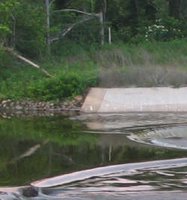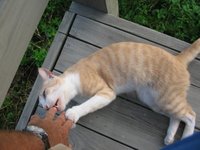More Grizzly/Egrets
 Sunrise yesterday morning.
Sunrise yesterday morning.Took another trip yesterday at sundown to the low-water control structure south of Henderson. I wanted to see the difference in the appearance of the structure and the water at 9 feet (BLR gauge a couple weeks ago) and at 5 feet now. The difference was dramatic. There is no longer turbulence over the structure resembling what you expect on a white-water rafting stream. Instead, there are four-foot waterfalls. And somehow, fish are still making it up the waterfalls on their way upstream. You can actually see them leaping up the descending water – mostly gars and what looks like buffalo.
 And the birds are
And the birds are  collected on the structure to feed, and they still remind me of bears at streams up north, at least I think they are there to feed. I say that because I saw little evidence of successful fish-catching. Only one bird seemed to have found a good place to fish. The one at the far left of the concrete apron in the cropped photo below.
collected on the structure to feed, and they still remind me of bears at streams up north, at least I think they are there to feed. I say that because I saw little evidence of successful fish-catching. Only one bird seemed to have found a good place to fish. The one at the far left of the concrete apron in the cropped photo below.The birds I saw were the following: Great Egrets, Snowy Egrets (mostly), Great Blue Herons, Little Blue Herons, Green-backed Herons, Black-crowned Night Herons and Belted Kingfishers. It was interesting to see the birds that prefer feeding at night replacing those that feed by day, and I
 guess they really are night (feeding) herons, as the name suggests. They arrived as the light was fading and the sun had been set for quite a while. At first they landed at a distance from the water and just sat there and watched the egrets which had been there all day, I imagine. As it got later and later they seemed to become bolder and began to encroach on the egret’s fishing spots at the water’s edge. Finally, they just took over the spots where the egrets had been fishing and the egrets flew off to wherever they are roosting for the night. The egrets didn’t seem to contest the takeover, not fighting with the herons as they had display-fought with other egrets the whole time I was there.
guess they really are night (feeding) herons, as the name suggests. They arrived as the light was fading and the sun had been set for quite a while. At first they landed at a distance from the water and just sat there and watched the egrets which had been there all day, I imagine. As it got later and later they seemed to become bolder and began to encroach on the egret’s fishing spots at the water’s edge. Finally, they just took over the spots where the egrets had been fishing and the egrets flew off to wherever they are roosting for the night. The egrets didn’t seem to contest the takeover, not fighting with the herons as they had display-fought with other egrets the whole time I was there. There was a dead fish up on the structure where the birds were mostly walking around preening and chasing each other. It was the size of about a ten-inch mullet. It was too big for any of the birds to swallow, but many of them would come over and look at it, and maybe peck at it a little. None tried to pick it up. Except that there was one young night heron that just couldn’t seem to get used to the idea that here was something that really was food (it had that down) but was packaged wrong. Several times it came over to the dead fish, looked at it, pecked at it, looked at it some more, and walked away only to return to the fish a few minutes later and do the same thing all over again. It sure was confused – maybe like if we came upon a crawfish that weighed 50 pounds and we had no hands or tools or teeth to get bite-size pieces off of it. I sure hope it figured out how to find food in more manageable packages.
 One of these pictures shows the snowy egrets doing a humorous thing. They stand in the strong current in water about three inches deep and they let one leg trail behind in the current and just support themselves on the other leg. It just looks odd.
One of these pictures shows the snowy egrets doing a humorous thing. They stand in the strong current in water about three inches deep and they let one leg trail behind in the current and just support themselves on the other leg. It just looks odd.The purple martins are starting to gather in flocks. This must be in preparation for their return trip to South America, although it seems a little early for that. Around sunset, big bunches of them are on wires and old TV antennas around Butte La Rose.
Fished for about an hour in the river yesterday. Caught two gous, three channel cats, one barfish and three gars, all on shrimp. I found a paper-wasp nest under the deck of my boat. And I was very happy to find it before I was out in the river and happened to reach under the deck for something. There really aren’t many options when that happens, you give them the boat and decide you really wanted to take a swim anyway. Problem is, what do you do now, with you in the water with a bunch of defensive wasps looking for you, and the boat just floating downstream at the same pace you are – with the wasps staying with the boat. You get away from the boat, if you swim well, but how do you get the boat back? Glad I found them before all this happened, and before someone else might have been in the boat with me!
Anyway, I killed the adult wasps, took out the nest, broke open the little cells and used the white larvae to catch several bream from the dock. They really are good bait, if a bit hazardous to procure.
By the way, some people have asked why the big sea turtles are called Green Sea Turtles (see Gone For a Week) if nothing about them seems to be green. Well, something about them is green, apparently. It was told to me that when the whalers (blame it on them) found that the turtles were good to eat, they found that the fat was a green color, and that’s where the name came from. I offer this as hearsay.

Napoleon is feeling frisky these days.
The river is at 5.4 on the Butte La Rose gauge, and will stay about that for the next five days. The Mississippi and Ohio are falling all the way up. Low water is coming early this year.
Rise and Shine, Jim


0 Comments:
Post a Comment
<< Home